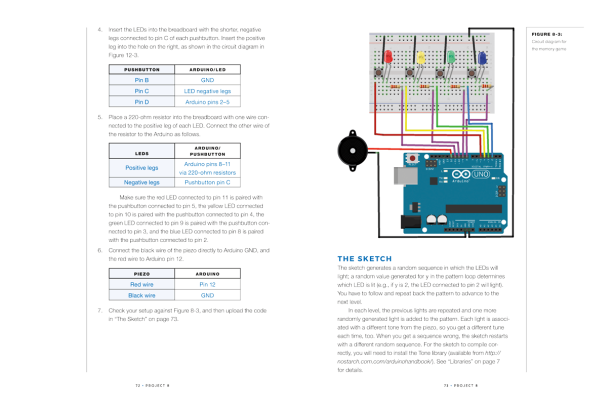 No Starch Press recently released a new book in the making space. This latest entry, titled Arduino Project Handbook by Mark Geddes, joins the many existing Arduino books on the market. Over the past few weeks I have been reading the book and making some of the projects. The book has a wealth of knowledge to share.
No Starch Press recently released a new book in the making space. This latest entry, titled Arduino Project Handbook by Mark Geddes, joins the many existing Arduino books on the market. Over the past few weeks I have been reading the book and making some of the projects. The book has a wealth of knowledge to share.
Overall, I really liked the book. I do want to get my one main complaint out of the way now. Based on the title and description, I was expecting a book of projects from start to finish. This book only goes as far as the breadboard. I was expecting projects to have enclosures and mounting of elections, a mixed-media problem faced by many new makers. However, none of the projects make it that far.

Sample page, used with permission from No Starch Press.
Once I adjusted my expectations, I really got into the book. Most projects are presented with some pictures and then a wiring schematic. You can see that in the sample page to the right or below. The wiring schematic uses symbols that closely match what the actual part looks like, instead of the traditional electronics schematic. This is really helpful for new makers. From both the wiring schematic and the pictures it is really easy to make sure you wired your project correctly.

Sample page, used with permission from No Starch Press.
All of the projects, save the last few, use the Arduino Uno. The last few projects do not use the Uno, rather using the ATMEGA328 on a breadboard. While still using the Arduino firmware, this is a good way for makers to condense the number of boards in a project.
The projects are creative and fun, ranging from blinking lights to a weather station. Some projects require just a few parts while others are a bit more complex. Many of the individual skills are easily applied to other projects. For example, several projects use an LCD screen or servo motors, two of the most common devices in maker projects. Furthermore, the sample code is clearly commented and published in the book. This is huge as many publishers are moving this content online, making it harder to follow. I found this helpful when working on my desk when my internet went down. I was able to keep tinkering and following the instructions without having to worry about reaching the publisher’s website.
Overall this is another great Arduino book. Mark Geddes does a great job of showing how new makers can leverage an Arduino. I recommend the Arduino Project Handbook for any aspiring makers and those new to electronics! You can find the book on amazon for under $20. For that price, I think it would be a great addition to any maker’s library!

